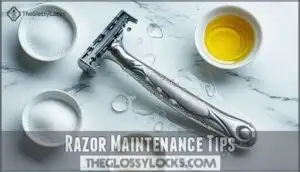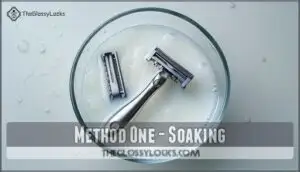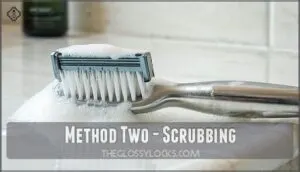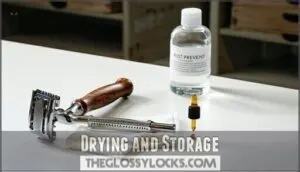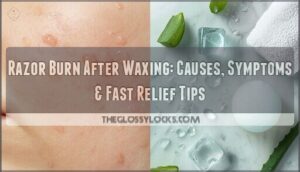This site is supported by our readers. We may earn a commission, at no cost to you, if you purchase through links.
 You can clean your razor naturally using simple household items that pack a powerful punch.
You can clean your razor naturally using simple household items that pack a powerful punch.
Mix one part white vinegar with four parts water, then soak your razor for ten minutes to dissolve soap scum and mineral buildup.
For stubborn grime, create a paste with baking soda and water, gently scrubbing with an old toothbrush.
Tea tree oil works wonders as a natural antiseptic when mixed with warm water.
Rubbing alcohol provides excellent sanitization between uses, while hydrogen peroxide tackles bacteria effectively.
These natural ways to clean razor blades keep them sharp and hygienic without harsh chemicals.
Proper maintenance techniques can extend your blade’s lifespan substantially.
Table Of Contents
- Key Takeaways
- Natural Razor Cleaning
- Sanitizing Razor Blades
- Razor Maintenance Tips
- Cleaning Safety Razors
- Razor Longevity Secrets
- Frequently Asked Questions (FAQs)
- What can I use to clean my razor?
- Can I clean a razor with vinegar?
- How to get rid of bacteria on razors?
- Can lemon juice effectively clean razor blades?
- How often should razors be deep cleaned?
- Are natural cleaning methods safe for electric razors?
- What household items remove stubborn razor residue?
- Do natural cleaners work on disposable razors?
- Conclusion
Key Takeaways
- You can clean your razor naturally using white vinegar mixed with water (1:4 ratio) to dissolve soap scum and mineral buildup, or create a baking soda paste for stubborn grime that won’t damage your blades.
- You’ll eliminate harmful bacteria by sanitizing your razor with rubbing alcohol or hydrogen peroxide after each use, which prevents infections and extends your blade’s lifespan without harsh chemicals.
- You should disassemble safety razors completely for thorough cleaning, then dry all components properly and store them in a cool, dry place to prevent rust and bacterial growth.
- You’ll maximize your razor’s performance by establishing a daily cleaning routine with warm water rinses, weekly deep cleaning sessions, and regular blade replacements every 5-10 uses depending on your shaving frequency.
Natural Razor Cleaning
You don’t need expensive commercial cleaners to maintain a hygienic razor when common household items work just as effectively.
Natural cleaning methods using white vinegar, tea tree oil, and baking soda eliminate bacteria buildup while extending your razor’s lifespan without harsh chemicals.
Using White Vinegar Solution
White vinegar transforms your razor cleaning routine with its natural disinfecting power.
Nature’s powerhouse cleaner cuts through grime and bacteria, revolutionizing your daily shaving ritual with pure, chemical-free effectiveness.
Mix one part white vinegar with four parts water for ideal vinegar concentration.
Soak your razor in this solution for 15 minutes at room temperature—solution temperature doesn’t need adjustment.
This natural sanitizer eliminates bacteria while tackling rust removal effectively.
You can find white vinegar here for your cleaning needs.
Vinegar alternatives include lemon juice, though white vinegar remains superior for razor cleaning due to its natural properties.
Tea Tree Oil Benefits
Another powerful natural cleaning option comes from tea tree oil, which packs serious antimicrobial punch.
This natural disinfectant offers multiple advantages for razor care:
- Antibacterial effects eliminate harmful germs on blade surfaces
- Antifungal properties prevent mold growth in humid bathrooms
- Skin benefits reduce irritation from shaving nicks
- Scent advantages leave your razor smelling fresh
- Natural disinfectant action replaces harsh chemicals effectively
The advantages of using tea tree oil for razor care are clear, making it a valuable addition to any shaving routine.
Baking Soda Method
Baking soda creates an effective homemade razor cleaner when mixed with water to form a paste consistency.
This natural cleaning solution provides gentle abrasive cleaning that removes buildup without scratching blades.
The eco-friendly cleaning method excels at rust removal while being safer than harsh chemicals.
Simply apply the paste, scrub gently with an old toothbrush, then rinse thoroughly for best results.
Sanitizing Razor Blades
You’ve already cleaned your razor with natural solutions, but sanitizing the blades takes your hygiene routine to the next level by eliminating harmful bacteria that can cause infections.
Proper sanitization using common household items like rubbing alcohol and hydrogen peroxide guarantees your razor remains safe for daily use while extending its lifespan.
Rubbing Alcohol Effectiveness
Your razor’s biggest threat isn’t dullness—it’s bacteria. Rubbing alcohol stands as the gold standard for razor sanitization, offering unmatched Alcohol Disinfection Power against harmful microbes.
Your razor’s deadliest enemy lurks invisible—bacteria breeding in every crevice, waiting to strike your skin.
This antimicrobial solution eliminates germs while protecting your investment. Many retailers offer alcohol disinfectant options for purchase.
Here’s why alcohol works so well:
- Quick action – Kills bacteria instantly upon contact
- Clean finish – High Evaporation Rate leaves no residue behind
- Blade Protection – Prevents rust while maintaining sharpness
Hydrogen Peroxide Solution
Everyone’s medicine cabinet likely contains hydrogen peroxide, making it one of the most accessible natural cleaning solutions for razor sanitization.
You’ll find this mild antiseptic effectively kills bacteria while remaining gentle on your skin.
Simply create a 3% solution, soak your disassembled razor for five minutes, then rinse thoroughly before air-drying completely.
| Factor | Recommendation |
|---|---|
| Peroxide Concentration | Use 3% household solution |
| Disinfection Time | Soak for 5 minutes maximum |
| Skin Sensitivity | Rinse thoroughly after cleaning |
Preventing Bacterial Growth
Between shaves, harmful bacteria multiply rapidly on damp razor surfaces, creating infection risks that proper sanitization methods can eliminate.
You’ll prevent bacterial growth by disinfecting your razor blade after each use with natural sanitizers like rubbing alcohol or hydrogen peroxide.
Never share razors, as this spreads dangerous bacteria types. These razor hygiene tips guarantee your razor sanitization routine protects against skin infections effectively, ensuring a safe and healthy shaving experience with proper sanitization methods.
Razor Maintenance Tips
You’ll extend your razor’s lifespan and maintain peak performance by establishing consistent maintenance habits that go beyond basic cleaning.
Proper daily care, strategic storage methods, and regular disinfection practices work together to prevent bacterial buildup, reduce corrosion, and guarantee your razor delivers smooth, irritation-free shaves for months to come, by establishing consistent maintenance habits.
Daily Cleaning Routine
Throughout the day’s shave, maintaining your razor doesn’t require complicated rituals.
A proper daily cleaning routine keeps blades sharp and prevents bacterial buildup that leads to skin irritation.
Here’s your essential daily razor cleaning checklist:
- Quick Rinse – Run warm water over blades before and after each shave
- Stroke Cleaning – Rinse between every few strokes during shaving
- Residue Removal – Gently shake off excess water and debris
- Blade Inspection – Check for hair clogs or soap buildup
- Razor Drying – Pat dry with clean towel after use
Storage and Handling
After cleaning your razor daily, proper razor storage becomes your next priority for razor maintenance.
Store your razor in a cool, dry location with good humidity control to prevent bacterial growth.
Use travel cases with blade protection when moving your razor around.
Keep your razor organization simple by using a dedicated stand that allows airflow, ensuring proper razor care and razor hygiene while enabling safe disposal when needed.
Regular Disinfection
Weekly razor sanitization keeps your blades performing like new while protecting your skin from nasty infections.
Your disinfection frequency should match your shaving schedule—daily shavers need twice-weekly cleaning, while occasional users can disinfect weekly.
- Solution strength matters: Use 70% rubbing alcohol for maximum bacterial elimination
- Contact time counts: Let disinfectant sit for 30 seconds before rinsing
- Proper drying prevents rust: Air-dry completely before storage
Cleaning Safety Razors
Safety razors require complete disassembly for thorough cleaning, since bacteria and debris accumulate between the blade and handle components.
You’ll need to soak, scrub, and properly dry each part to maintain ideal hygiene and prevent skin infections.
Method One – Soaking
Your razor’s first deep-clean begins with proper disassembly and soaking.
Remove all components, then submerge them in warm white vinegar solution for fifteen minutes—this soaking duration allows natural cleaning methods to break down buildup effectively.
The solution temperature should feel comfortably warm, not scalding.
After soaking, perform gentle water rinsing before moving to drying methods that prevent moisture retention.
Method Two – Scrubbing
When soaking doesn’t tackle stubborn buildup, scrubbing becomes your go-to natural razor cleaning method. Use a soft bristle brush with gentle pressure application to avoid damaging delicate components.
Select mild soap or DIY razor cleaner for effective residue removal. A great option is to use a gentle cleaning product.
Apply proper scrubbing techniques by working in small circles, focusing on crevices where debris hides. These razor cleaning tips guarantee thorough natural cleaning methods with proper scrubbing.
Drying and Storage
After scrubbing your safety razor thoroughly, proper drying becomes your next priority.
You’ll want to shake off excess water first, then choose between airing vs. towel methods for complete moisture removal.
A dry environment prevents rust formation and guarantees blade protection through these essential storage steps:
- Pat components with lint-free cloth
- Allow complete air drying
- Store in ventilated storage containers
- Keep away from humid areas
- Apply rust prevention oil weekly
This razor maintenance routine protects your investment while guaranteeing superior razor sanitization for future shaves.
Razor Longevity Secrets
You can extend your razor’s lifespan substantially by implementing three essential maintenance practices that prevent corrosion, protect blade edges, and guarantee peak performance.
These proven techniques will help you avoid costly blade replacements while maintaining the sharpness and hygiene standards necessary for comfortable, effective shaving, which can be achieved by following the essential maintenance practices.
Avoiding Rust and Corrosion
After every shave, proper rinsing removes soap residue that accelerates razor corrosion.
Blade drying is essential—shake off excess water and pat completely dry with a clean towel.
Dry storage prevents moisture buildup that causes razor rust.
Material selection matters too; stainless steel resists corrosion better than carbon steel.
These simple steps prevent razor rust naturally without harsh chemicals, using methods like proper rinsing and dry storage to maintain your razor.
Using Maintenance Oils
Think of maintenance oils as your razor’s personal bodyguard against time and elements.
Oil application creates a protective barrier for blade protection and corrosion prevention.
Apply camellia or mineral oil weekly, ensuring material compatibility with your razor’s components.
This simple razor maintenance tip dramatically improves extending lifespan while maintaining peak performance.
Natural razor care doesn’t get easier than this essential razor blade cleaning step.
Replacing Blades Regularly
Beyond proper oiling, blade replacement frequency determines your razor’s performance and hygiene.
Dull blades cause shaving discomfort signs like pulling, nicks, and irritation. Most cartridges last 5-7 shaves, while safety razor blades need changing every 5-10 uses.
Razor blade replacement indicators:
- Tugging sensation – blade sharpness decline causes hair pulling
- Increased pressure needed for clean cuts
- Visible nicks or irritation after shaving
- Rust spots compromising hygiene considerations
- Multiple passes required for smoothness
Cost-effectiveness analysis shows timely blade longevity maintenance prevents skin damage.
Frequently Asked Questions (FAQs)
What can I use to clean my razor?
Like a kitchen knife dulled by neglect, your razor needs proper care to perform.
You can clean it with rubbing alcohol, hydrogen peroxide, white vinegar solution, or mild soap and warm water for maximum hygiene.
Can I clean a razor with vinegar?
Yes, you can clean your razor with white vinegar.
Mix one part vinegar with four parts water, soak the disassembled razor for fifteen minutes, then scrub and rinse thoroughly before drying completely.
How to get rid of bacteria on razors?
Bacteria multiply like wildfire on razor blades.
You’ll want to soak your razor in rubbing alcohol for five minutes, then rinse with warm water.
This kills germs effectively and keeps your skin infection-free.
Can lemon juice effectively clean razor blades?
Lemon juice’s natural acidity can help clean razor blades by breaking down mineral deposits and bacteria.
However, it’s less effective than rubbing alcohol or hydrogen peroxide for thorough sanitization and disinfection.
How often should razors be deep cleaned?
Deep clean your razor weekly if you shave daily, or after every 5-7 shaves.
More frequent cleaning’s needed if you notice buildup, irritation, or reduced performance.
Regular maintenance keeps blades sharp and prevents bacterial growth.
Are natural cleaning methods safe for electric razors?
Electric razors require caution with natural cleaners.
You shouldn’t use liquids like vinegar or oils on internal components.
Instead, use dry methods like soft brushes for external cleaning, following manufacturer guidelines to avoid damage, and remember to exercise caution.
What household items remove stubborn razor residue?
While commercial cleaners promise perfection, your kitchen cabinet holds the real cleaning champions.
You’ll find white vinegar, baking soda, and rubbing alcohol tackle stubborn buildup effectively, removing hair, soap scum, and mineral deposits without harsh chemicals, using baking soda as a key component.
Do natural cleaners work on disposable razors?
Yes, natural cleaners work effectively on disposable razors.
You can use white vinegar, rubbing alcohol, or baking soda solutions to remove buildup and sanitize blades.
This process extends their lifespan and improves shaving performance safely.
Conclusion
Mastering these natural ways to clean razor blades will revolutionize your grooming routine forever.
You’ve discovered five effective methods using common household items like vinegar, baking soda, and tea tree oil.
These techniques eliminate bacteria, prevent rust, and extend blade life without harsh chemicals.
Regular cleaning with these natural solutions keeps your razor performing at its best while maintaining proper hygiene.
You’ll save money on replacements and enjoy consistently smooth shaves by implementing these simple maintenance practices consistently.




